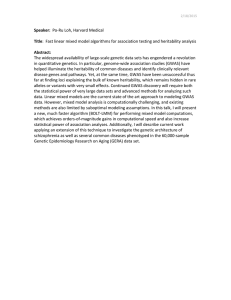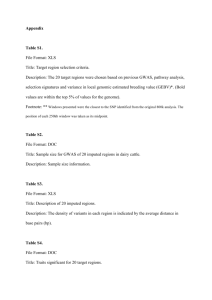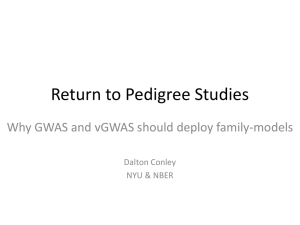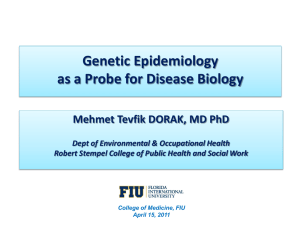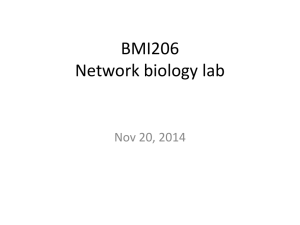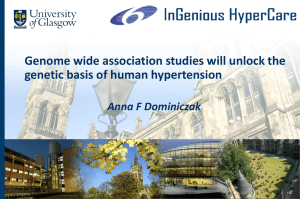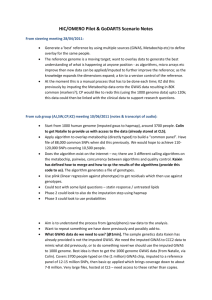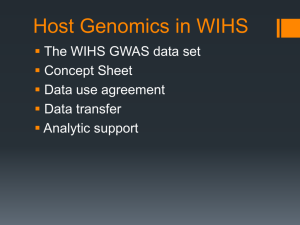Genetic Predictors of Perioperative Cardiac Outcomes
advertisement
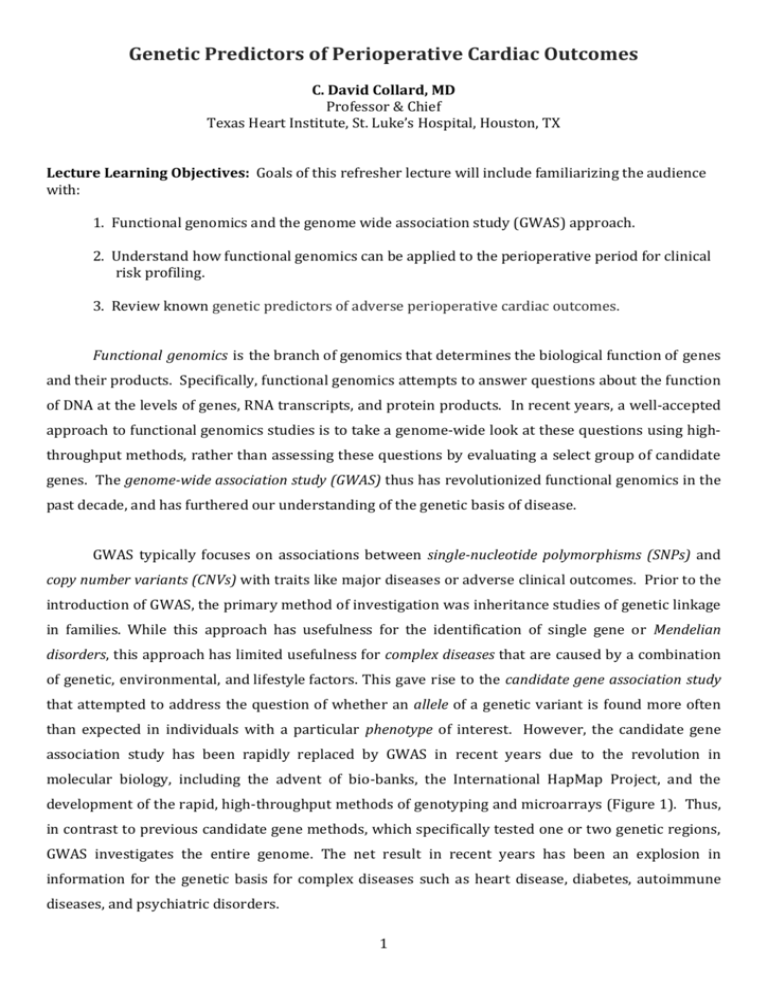
Genetic Predictors of Perioperative Cardiac Outcomes C. David Collard, MD Professor & Chief Texas Heart Institute, St. Luke’s Hospital, Houston, TX Lecture Learning Objectives: Goals of this refresher lecture will include familiarizing the audience with: 1. Functional genomics and the genome wide association study (GWAS) approach. 2. Understand how functional genomics can be applied to the perioperative period for clinical risk profiling. 3. Review known genetic predictors of adverse perioperative cardiac outcomes. Functional genomics is the branch of genomics that determines the biological function of genes and their products. Specifically, functional genomics attempts to answer questions about the function of DNA at the levels of genes, RNA transcripts, and protein products. In recent years, a well-accepted approach to functional genomics studies is to take a genome-wide look at these questions using highthroughput methods, rather than assessing these questions by evaluating a select group of candidate genes. The genome-wide association study (GWAS) thus has revolutionized functional genomics in the past decade, and has furthered our understanding of the genetic basis of disease. GWAS typically focuses on associations between single-nucleotide polymorphisms (SNPs) and copy number variants (CNVs) with traits like major diseases or adverse clinical outcomes. Prior to the introduction of GWAS, the primary method of investigation was inheritance studies of genetic linkage in families. While this approach has usefulness for the identification of single gene or Mendelian disorders, this approach has limited usefulness for complex diseases that are caused by a combination of genetic, environmental, and lifestyle factors. This gave rise to the candidate gene association study that attempted to address the question of whether an allele of a genetic variant is found more often than expected in individuals with a particular phenotype of interest. However, the candidate gene association study has been rapidly replaced by GWAS in recent years due to the revolution in molecular biology, including the advent of bio-banks, the International HapMap Project, and the development of the rapid, high-throughput methods of genotyping and microarrays (Figure 1). Thus, in contrast to previous candidate gene methods, which specifically tested one or two genetic regions, GWAS investigates the entire genome. The net result in recent years has been an explosion in information for the genetic basis for complex diseases such as heart disease, diabetes, autoimmune diseases, and psychiatric disorders. 1 Figure 1. GWAS Discoveries over Time. (http://www.genome.gov/multimedia/illustrations/Published_GWA_Reports_6-2012.pdf) In general terms, GWAS compares the DNA of two groups: people with the disease or outcome of interest (cases) and similar people without the disease outcome (controls). Each person gives a sample of DNA, from which millions of genetic variants are read using SNP arrays. If one type of the variant (one allele) is more frequent in people with the disease, the SNP is said to be "associated" with the disease. The associated SNPs are then considered to mark a region of the human genome, which influences the risk of disease. Thus, GWAS provides an unbiased approach to identifying SNPs within genetic loci that are associated with the outcome phenotype. One of the advantages of the GWAS approach is that it is unbiased with respect to genomic structure and previous knowledge of the trait etiology, in contrast to candidate gene studies, where knowledge of the trait is used to identify candidate loci contributing to the trait of interest. This allows identification of novel loci and potential new understanding of biology related to disease phenotype. While GWAS studies may identify genetic variants that are associated with a disease or clinical outcome of interest, they do not specify which genes are causal. Additional follow-up studies such as high-throughput DNA and RNA sequencing are now providing tools for understanding how disease loci influence gene expression. Indeed, recently a new class of polymorphisms called expression quantitative trait loci (eQTL) were identified. These variants associate with gene expression levels but have been hard to map because they act from unpredictably long distances from causative genes, often from different chromosomes. Nonetheless, 2 DNA and RNA sequencing is becoming a useful tool for helping with mechanistic understanding of GWAS generated data. The number of SNPS interrogated in GWAS is often greater than a million. Additionally, clinical variables that could potentially confound the resultant genetic associations have to be accounted for, including gender, age, ethnicity and pertinent medical history. Whether the allele frequency is significantly altered between the GWAS case and control groups is determined by a statistically derived odds ratio. Needless to say, these computations are derived from very large datasets and generally should be preformed by individuals with expertise in genetic statistics using specialized bioinformatics software. After all of the SNP odds ratios and P-values have been calculated, magnitude of genetic associations for the entire large dataset of SNPs are commonly displayed in a “Manhattan plot” (Figure 2). This plot typically shows the negative logarithm of the P-value as a function of genomic location. Thus, the SNPs with the most significant association stand out. As millions of tests are performed, the results must be adjusted to control for false positives. Thus, for 1 million SNPs tested, a GWAS threshold for significance is frequently thought to be P< 5 × 10–8. Moreover, a well-conducted GWAS typically performs the first analysis in a discovery cohort, followed by validation of the most significant SNPs in independent replication cohort. Figure 2. Manhattan plot of genetic variants associated with ventricular dysfunction after primary coronary artery bypass graft surgery. The –log P value of the allelic genetic model for each SNP according to location on the 22 autosomal chromosomes. Horizontal line indicates the 5 X10-8 P value threshold for genome-wide significance (PLoS ONE 2011 Sept 6(9): e24593). 3 Using GWAS coupled with DNA and RNA sequencing techniques, an exciting picture is emerging of unanticipated genetic overlap between what had initially been thought to be unrelated diseases and traits. To date, over 1,200 human GWA studies have examined over 200 diseases and traits, and almost 4,000 SNP associations have been found. However, the vast majorities of GWAS studies to date have been conducted in ambulatory patients and have not addressed perioperative outcomes. This session will review what is currently known about genetic predictors of perioperative cardiac outcomes. References Nat Rev Genet. 2012 Jan 18;13(2):135-45. PLoS ONE 2011 Sept 6(9): e24593. Nat Rev Genet. 2013 Jul;14(7):483-95. J Hum Genet. 2013 Nov 7; epub ahead of print. Am J Hum Genet. 2012 Jan 13;90(1):7-24. Genetics 2011 Feb 187: 367–383. Arterioscler Thromb Vasc Biol. 2012 32:169 4
